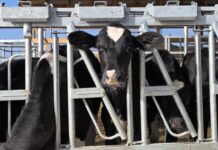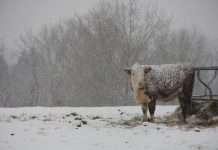Regrowth of pastures, for stockpiling, was almost non-existent this year due to the drought conditions.
While some managers in our area have been able to stockpile grass in a few paddocks, more stored forage will be required this year and feeding stored feed will start much sooner than in other years.
Quantities of stored feed may also be in short supply. Losses, attributed to feeding hay to livestock, may be much more than storage loss if precautions are not taken to reduce waste.
Waste. Feeding loss is a product of many things. Trampling, leaf shatter, quality deterioration, fecal contamination, and refusal all contribute to waste.
One must expect some hay loss during feeding, but the amount of loss may be reduced through good management practices.
Feeding losses have been shown to ranged from less than 2 percent, where great care was taken, to more than 60 percent when no attempt was made to reduce hay loss.
A loss of 3 percent to 6 percent would be considered normal, but good management practices must be enforced to accomplish this.
Feeding hay on sod from a moveable rack or wagon promotes distribution of manure rather than concentrating it in one location. Many types of feeding equipment are available, but those which keep hay from contacting the ground generally reduce waste the most.
Where to feed. A dry, well-drained or frozen site should be chosen for feeding hay. Limiting hay fed to a one-day supply, with enough space per animal, helps reduce waste.
Some managers like to feed in one area, which permits selection of a convenient feeding location and minimizes the area of sod killed. However, this eventually results in excessive sod destruction and muddy conditions promoting weed pressure.
It may also result in soil erosion or soil compaction. If these conditions are encountered, tilling and re-seeding the area will probably be necessary.
Unrolling large round bales is a practice which many of our producers have implemented where terrain and or equipment permit.
If this method is used, only unroll enough feed for one day’s supply or use an electric wire over the middle of the unrolled swath to prevent trampling and bedding on the food source.
Moving to a new area each feeding promotes even manure distribution. Many producers use this method to promote re-seeding in places with sparse vegetation.
Unused forages help to increase organic material in these feeding areas and increases fertility.
Feeding priority. Feeding priority of hay lots should also be considered when using the feed.
Hay exposed to the elements should be fed first to reduce loss, if indoor and outdoor storage is used.
Highest quality hay should be fed to young, growing livestock or lactating animals when stockpiled forages are gone.
Lower quality hay should be used for livestock with lower nutritional needs, such as bulls and non-lactating cows.
Lower quality hay may also be used to extend grazing of stockpiled paddocks. Most stockpiled grasses, when fed in a timely manner, contain higher protein levels than many lots of hay which were harvested in the summer.
If placing round bales in a stockpiled forage, one should use a front electric wire to limit access, thereby controlling waste of the stockpiled forage and the round bales.
Protect what you’ve got. A heavy use feeding area, constructed of concrete, geotextile cloth , or other suitable material, is a good place to feed livestock when conditions are not suitable in your fields.
Using heavy use areas at proper times reduces plugging and injury to forage plants in the paddocks. Whatever feeding method is used, your management decisions determine the impact.
The farm’s appearance reflects the manager’s ability to control problems. Remember too, the appearance of your farm plays an important part in what neighbors and others think about farming operations.
The overwhelming majority of the public only comes in contact with farm operations as they drive by. So, aesthetics and best management practices should be an important consideration where livestock feeding occurs.
Establishing good management practices can alleviate unsightly problems, reduce soil erosion, increase water quality and boost profit margins.
(The author is an OSU Extension Agriculture and Natural Resources Extension Agent in Monroe County, Ohio. Questions or comments can be sent in care of Farm and Dairy, P.O. Box 38, Salem OH 44460.)












